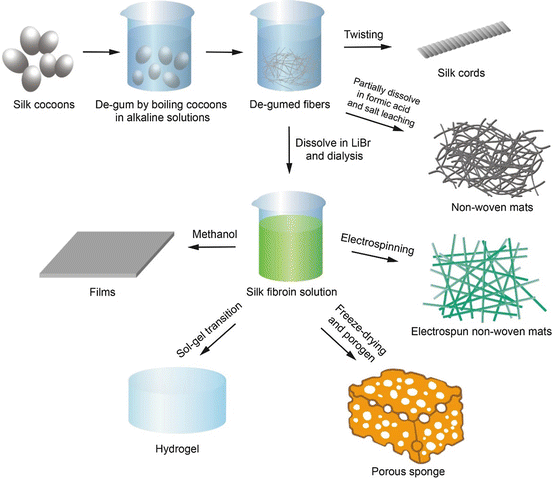

Zhou CZ, Confalonieri F, Jacquet M, Perasso R, Li ZG, Janin J.

The extraction of fibroin protein from Bombyx mori silk cocoon: optimization of process parameters. Degradation of sericin (degumming) of Persian silk by ultrasound and enzymes as a cleaner and environmentally friendly process. Mahmoodi NM, Arami M, Mazaheri F, Rahimi S. Effect of regeneration of liquid silk fibroin on its structure and characterization. Structure and solubility of natural silk fibroin. Sashina ES, Bochek AM, Novoselov NP, Kirichenko DA. Preparation of undegraded native molecular fibroin solution from silkworm cocoons. Yamada H, Nakao H, Takasu Y, Tsubouchi K. Isolation and processing of silk proteins for biomedical applications. Kundu B, Kurland NE, Yadavalli VK, Kundu SC. Comparative study of degumming of silk varieties by different techniques. Green degumming of silk by enzyme extracted from natural sources. Rahman M, Bhowmik A, Das S, Chowhan K, Biswas T. Degumming of silk fabric with several proteases. Int J Biol Macromol 2017 104:294.įreddi G, Mossotti R, Innocenti R. Effect of degumming methods on structural characteristics and properties of regenerated silk. Kim HJ, Kim MK, Lee KH, Nho SK, Han MS, Um IC. Effect of processing on silk-based biomaterials: reproducibility and biocompatibility. Wray LS, Hu X, Gallego J, Georgakoudi I, Omenetto FG, Schmidt D, Kaplan DL. Nat Protoc 2011 6:1612.Ĭhen J, Venkatesan H, Hu J. Materials fabrication from Bombyx mori silk fibroin. Rockwood DN, Preda RC, Yucel T, Wang X, Lovett ML, Kaplan DL. Conversion of biomass to selected chemical products. Fine chemicals: the industry and the business, 2nd ed. Enzymatic degradation of Bombyx mori silk materials: a review. Elucidating silk structure using solid-state NMR. Chem Soc Rev 2018 47:6486.Īsakura T, Suzuki Y, Nakazawa Y, Holland GP, Yarger JL. Silkworm silk-based materials and devices generated using bio-nanotechnology. Huang W, Ling S, Li C, Omenetto FG, Kaplan DL. Design of biodegradable, implantable devices towards clinical translation. Li C, Guo C, Fitzpatrick V, Ibrahim A, Zwierstra MJ, Hanna P, Lechtig A, Nazarian A, Lin SJ, Kaplan DL. Comparative study of strain-dependent structural changes of silkworm silks: insight into the structural origin of strain-stiffening. Guo C, Zhang J, Wang X, Nguyen AT, Liu XY, Kaplan DL. Structural comparison of various silkworm silks: an insight into the structure-property relationship. Guo C, Zhang J, Jordan JS, Wang X, Henning RW, Yarger JL. Crystal networks in silk fibrous materials: from hierarchical structure to ultra performance. Nguyen AT, Huang QL, Yang Z, Lin N, Xu G, Liu XY. Polymeric materials based on silk proteins. Analysis of the structure of Bombyx mori silk fibroin by NMR. ACS Appl Mater Interfaces 2016 8:21861.Īsakura T, Okushita K, Williamson MP. Silk as a biomaterial to support long-term three-dimensional tissue cultures. Adv Drug Deliv Rev 2013 65:457.Ībbott RD, Kimmerling EP, Cairns DM, Kaplan DL. Silk fibroin biomaterials for tissue regenerations. Design, fabrication, and function of silk-based nanomaterials. Wang Y, Guo J, Zhou L, Ye C, Omenetto FG, Kaplan DL, Ling S. Engineering silk materials: from natural spinning to artificial processing. Silk protein-based hydrogels: promising advanced materials for biomedical applications. New opportunities for an ancient material. 7,000 year of Chinese silk science and technology, 1st ed. We also discuss the challenges and opportunities of these chemically modified silk proteins. This review summarizes the recent progress on chemical modification of silk proteins, focusing on the methodologies and applications. Furthermore, inspired by the traditional fine chemical industry based on synthetic chemistry, developing silk-based fine chemicals with special functions can significantly extend the applications of silk materials, particularly in biomedical fields. A chemical toolbox for modifying the silk proteins is required to achieve versatile silk-based materials with precisely designed properties or functions for different applications. However, most of these materials are based on natural silk proteins without chemical modification, leading to limited control of properties and functions (e.g., biodegradability and bioactivity). With the advances in silk processing technologies, a broad range of intriguing silk-based functional biomaterials have been made and applied for various biomedical uses. Recently, silk has been redefined as a protein-based biomaterial with great potential in biomedical applications owing to its excellent mechanical properties, biocompatibility, and biodegradability. Silk extracted from the cocoon of silkworm has been used as textile materials for thousands of years.


 0 kommentar(er)
0 kommentar(er)
